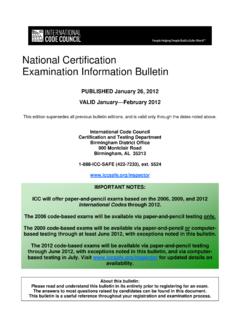Transcription of A Human Factors Roadmap for the Management …
1 A Human Factors Roadmap for the Management of Major Accident Hazards Introduction The following framework is intended to guide the reader through a practical approach for linking major accident hazards (MAH) to the assured performance of humans engaged on safety critical tasks associated with those hazards. The framework is presented as a Human Factors journey with key milestones. For each of the milestones there is a link to Human Factors topics which may be investigated by Seveso inspectors. Most of these topics are described in more detail in the UK Human Factors Inspectors Toolkit. The Framework Maintenance & Inspection Human Error Analysis Task Analysis Training Consolidation Competence Assurance Monitor & Review Procedures Safety Critical Tasks Task Analysis Human Error Analysis PIFs Engineering/ Automation PIFs Major Accident Hazard Scenarios Assured Human Performance 1 The Milestones Major Accident Hazard Scenarios Where a site has produced a safety report the main site hazards should have been identified in their MAH scenarios.
2 For sites which do not produce a safety report the main site hazards should have been identified by an appropriate method of risk assessment. Inspection Topics: Safety report assessment. SMS / Predictive risk assessment Safety Critical Tasks This is where the site should identify those tasks associated with their main site hazards where humans may initiate or fail to mitigate a major incident. This will involve the identification of safety critical roles and responsibilities for staff at all levels within the organisation. Inspection topics: SMS Emergency response Organisational change Task Analysis Having identified the safety critical tasks, these tasks need to be clearly defined and understood. This is achieved by carrying out a suitable task analysis. This could be as simple as a walk through / talk through of the task writing down what should be done, where and when it should be done, who should be doing it, how to do it and why it is important (especially for safety).
3 For more complex tasks a formal Human Factors task analysis tool may be required. Inspection topics: Identifying Human failure Human Factors in accident investigation Human Error Analysis Once the task has been clearly defined, each step can be assessed for the potential for Human failure and/or the opportunity to recover from Human failure. This is often achieved through a process similar to HAZOP but using Human Factors guide words (see Core Topic 3 in UK HF Toolkit). Inspection topics: Identifying Human failure Human Factors in accident investigation 2 Operational Performance Influencing Factors (PIF) During Human error analysis it is important to consider those Factors which make it more or less likely that the Human (s) will fail. Some examples of operational PIFs are: Ergonomics Design lighting, VDE workstation. Human machine interfaces control screens, tanker loading bay. Inspection topics: Identifying Human failure Human Factors in accident investigation Alarm handling Managing fatigue risks Engineering / Automation Controls Using a hierarchy of control approach, the first step in dealing with Human failure should be to engineer out the Human or provide additional layers of protection which do not rely on Human action high level trip on storage tank.
4 However, to assure the continued performance of these engineered layers of protection they need to be regularly inspected tested and maintained. Inspection topics: Alarm handling Inspection, Testing and Maintenance Replacing humans with engineering controls such as safety instrumented systems does not completely remove the Human from the safety Management system. The actual effect of such systems on the role of the Human is to shift the emphasis for Human failure away from operational activities and into inspection, testing and maintenance activities. The site now has a new category of Human failures to deal with. Inspection topics: Maintenance error Task Analysis (Maintenance) The same task analysis tools can be applied as above. The main difference here is the potential for the Human to introduce latent errors which may not result in immediate failure. Inspection topics: Identifying Human failure Human Factors in accident investigation Maintenance error Human Error Analysis (Maintenance) Again, the same techniques may be used as above taking care to apply the appropriate Human HAZOP guide words.
5 3 Inspection topics: Identifying Human failure Human Factors in accident investigation Maintenance error Maintenance PIFs Some of the performance influencing Factors will be the same as for operational activities but there may be some more specific to inspection, testing and maintenance with the potential to introduce latent failures into the engineered system. Some examples of maintenance PIFs are: Work planning Supervision PTW / Isolation procedures Task design Inspection topics: Identifying Human failure Human Factors in accident investigation Maintenance error Managing fatigue risks Procedures Procedures are used to support the humans engaged on safety critical tasks. The process of task analysis produces detailed task descriptions which can be readily converted into formal procedures. Different types of procedure provide control for the different types of Human failure.
6 Detailed procedures can provide a control for gaps in knowledge which lead to mistakes. Simplified procedures and job aids such as checklists provide controls for slips and lapses. It is important that the usable and use of procedures is monitored. Inspection topics: SMS Reliability and usability of procedures Safety critical communications Training Training provides the knowledge humans need in order to carry out the safety critical tasks. It is this knowledge which will make the possibility of mistakes less likely. Detailed procedures which describe how a task is completed can form the basis of a training manual. However, for a complete training package, information on why certain things are important and an understanding of the associated major hazard potential are necessary. Inspection topics: SMS Reliability and usability of procedures Maintenance error 4 Safety critical communications Consolidation The ability to follow a procedure is not a demonstration of competence.
7 The knowledge gained through training needs to be applied on the job to develop the skills and understanding required to complete the task safely and successfully. During the consolidation period, newly trained people will need extra support from good procedures, job aids and supervision. Inspection topics: Reliability and usability of procedures Safety critical communications Competence Assurance For competence to be assured, the criteria for success need to be established. A competence Management system should state the required standard of performance and how individuals will be monitored against the standard. Inspection topics: SMS Reliability and usability of procedures Safety critical communications Competence assurance Maintenance error Monitor & Review There will be constant change in any company whether it is staff retiring, modifications to existing plant or Management reorganisations.
8 Where changes may alter the risk profile of the site or impact upon the established controls for major accidents the demonstration of assured performance of humans engaged on safety critical tasks will need to be reviewed. This is where the link between Human Factors and the POPMAR model for safety Management systems is made. Inspection topics: SMS Safety culture Organisational change and transition Management Safety report assessment 5 6 Assured Human Performance Having taken all the practical steps outlined above it should be possible to provide evidence to demonstrate the assured performance of humans engaged on safety critical tasks which may have an influence on the initiation or mitigation of a major accident. This is the main demonstration the duty holder has to make in their safety report for Human Factors . Having clearly defined procedures for carrying out task analysis, Human error analysis, assessment of competence, etc allows the duty holder to demonstrate a structured approach.
9 Having examples of how these procedures are applied to the range of processes on site that contribute to the major hazard risks allows the duty holder to demonstrate a systematic approach. It is this structured, systematic approach to the Management of Human performance which should be clearly and concisely communicated within the site safety report to make the necessary demonstrations to the competent authority that the measures taken will prevent foreseeable failures which could lead to major accidents. Inspection topics: Safety report assessment Further Guidance Alan Jackson HID/CI3H Onshore Human & Organisational Factors Team













